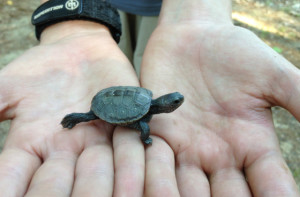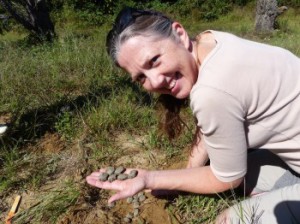
 The last few weeks have been busy ones at Nockum Hill, as a team of volunteers helped nearly 400 diamondback terrapin hatchlings make their way from protected nest sites into the water at Hundred Acre Cove. Barrington resident Charlotte Sornborger has been working with the diamondback terrapins at Nockum Hill for years. In a recent e-mail, Ms. Sornborger wrote that “it appears that all the hatching under the excluders for this year is done — 384 in all. According to research studies, about 1-2 percent of them will live to maturity to reproduce. There are probably some nests not protected that have also released the little terrapins.” Amy O’Donnell, a new member of the board of the Barrington Land Conservation Trust and a member of the volunteer terrapin team, shows off some of the newest arrivals at Nockum Hill. Photo courtesy of Pete McCalmont.There were also some nests raided by predators. About a quarter-mile from the gate marking the entrance to Nockum Hill — it’s located off George Street in the northern section of town — is a well-maintained trail leading to the main nesting site. The large field has mostly sandy soil and is covered sparsely with wildflowers and straggly grass. Volunteers had earlier marked the terrapin nests and installed caged excluders over them. The excluders are made mostly of heavy gage metal mesh formed into a dome of sorts. When the terrapins hatch, they are unable to crawl out of the cage; volunteers traveled daily to Nockum Hill to check the excluders for hatchlings and transport the tiny creatures a few hundred yards south to the water. A baby terrapin climbs a wire cage that protected its nest. Photo by Butch Lombardi – Eastbayimages.com Interspersed around the field was evidence of predators. Thin, paper-like turtle shells were strewn near the dug-out holes, marking where a raccoon or some other animal had feasted. Still, many more of the creatures reached Hundred Acre Cove. Eventually, some of the tiny terrapins will grow large and later return to the wooded confines of Nockum Hill to lay their own eggs. Volunteers said that this year saw a greater number of female hatchlings than in prior years. – See more at: http://www.eastbayri.com/news/diamondbacks-dig-out-in-barrington/
The last few weeks have been busy ones at Nockum Hill, as a team of volunteers helped nearly 400 diamondback terrapin hatchlings make their way from protected nest sites into the water at Hundred Acre Cove. Barrington resident Charlotte Sornborger has been working with the diamondback terrapins at Nockum Hill for years. In a recent e-mail, Ms. Sornborger wrote that “it appears that all the hatching under the excluders for this year is done — 384 in all. According to research studies, about 1-2 percent of them will live to maturity to reproduce. There are probably some nests not protected that have also released the little terrapins.” Amy O’Donnell, a new member of the board of the Barrington Land Conservation Trust and a member of the volunteer terrapin team, shows off some of the newest arrivals at Nockum Hill. Photo courtesy of Pete McCalmont.There were also some nests raided by predators. About a quarter-mile from the gate marking the entrance to Nockum Hill — it’s located off George Street in the northern section of town — is a well-maintained trail leading to the main nesting site. The large field has mostly sandy soil and is covered sparsely with wildflowers and straggly grass. Volunteers had earlier marked the terrapin nests and installed caged excluders over them. The excluders are made mostly of heavy gage metal mesh formed into a dome of sorts. When the terrapins hatch, they are unable to crawl out of the cage; volunteers traveled daily to Nockum Hill to check the excluders for hatchlings and transport the tiny creatures a few hundred yards south to the water. A baby terrapin climbs a wire cage that protected its nest. Photo by Butch Lombardi – Eastbayimages.com Interspersed around the field was evidence of predators. Thin, paper-like turtle shells were strewn near the dug-out holes, marking where a raccoon or some other animal had feasted. Still, many more of the creatures reached Hundred Acre Cove. Eventually, some of the tiny terrapins will grow large and later return to the wooded confines of Nockum Hill to lay their own eggs. Volunteers said that this year saw a greater number of female hatchlings than in prior years. – See more at: http://www.eastbayri.com/news/diamondbacks-dig-out-in-barrington/
